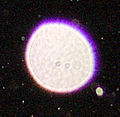Backscatter (photography): Difference between revisions
m Reverted edits by 50.130.84.37 (talk) to last revision by Andy Dingley (HG) |
No edit summary |
||
| Line 1: | Line 1: | ||
[[Image:FortGhost.jpg|thumb|right|250px|A single orb in the center of the photo, at the person's knee level]] |
|||
The term '''''orb''''' describes unexpected, typically circular artifacts that occur in [[flash photography]] — sometimes with trails indicating motion — especially common with modern [[compact digital camera|compact and ultra-compact digital cameras]]. |
The term '''''orb''''' describes unexpected, typically circular artifacts that occur in [[flash photography]] — sometimes with trails indicating motion — especially common with modern [[compact digital camera|compact and ultra-compact digital cameras]]. |
||
Revision as of 22:32, 16 November 2011
The term orb describes unexpected, typically circular artifacts that occur in flash photography — sometimes with trails indicating motion — especially common with modern compact and ultra-compact digital cameras.
Orbs are also sometimes called backscatter, orb backscatter, or near-camera reflection.
Cause
Orb artifact are captured during low-light instances where the camera's flash is used, such as at night or underwater – or where a bright light source is near the camera.
The artifacts are especially common with compact or ultra-compact cameras, where the short distance between the lens and the built-in flash decreases the angle of light reflection to the lens, directly illuminating the aspect of the particles facing the lens and increasing the camera's ability to capture the light reflected off normally sub-visible particles.[1]
The orb artifact can result from retroreflection of light off solid particles (e.g., dust, pollen), liquid particles (water droplets, especially rain) or other foreign material within the camera lens.[1]
The image artifacts usually appear as either white or semi-transparent circles, though may also occur with whole or partial color spectrums, purple fringing or other chromatic aberration. With rain droplets, an image may capture light passing through the droplet creating a small rainbow effect.
In underwater conditions, particles such as sand or small sea life close to the lens, invisible to the diver, reflect light from the flash causing the orb artifact in the image. A strobe flash, which distances the flash from the lens, eliminates the artifacts.
Below are two diagrams of a hypothetical underwater instance. In Diagram A, the faces of particles directly aligned with the camera's lens are illuminated by the flash, and thus the camera will more likely record orbs. In Diagram B, the faces of particles illuminated by the flash do not face the lens and therefore remain un-recorded.

Example images
Examples of orb artifacts reflecting solid or liquid particles:
-
Dust orb
-
Dust orbs
-
Thick charcoal dust
-
Charcoal dust floating in the air
-
Rain orbs, camera zoomed out
-
Forest orbs
-
Rain orbs, camera zoomed in
-
Rain orbs with coma (tails) and chromatic aberration
-
Close up orb, showing purple fringing
Paranormal interpretation
Orb backscatter has been broadly interpreted as a highly variable range of paranormal phenomenon without verifiable causation — including invisible spirits, auras, angels, ghosts, energy fields, psycho-energetic artifacts, energy balls, etc.[2][3][4][5]
References
- ^ a b "The Truth Behind 'Orbs'".
- ^ "Enough with the Orbs Already,Stephen Wagner". About.com.
- ^ "A Life in the Day Klaus Heinemann". The Times. London. 31 August 2008.
- ^ http://www.assap.org/newsite/htmlfiles/Orb%20FAQ.html
- ^ http://paranormal.about.com/od/ghostphotos/ig/Orbs-Debate-Photos/Antique-orb.htm
External links
- The science of orb photos: a mathematical framework for orbs/backscatter, using holography theory.
- The science behind orb/backscatter.
- The Orb Video Archive.
- How to take photos with orbs/backscatter.
- How to avoid orbs/backscatter in underwater photos with orbs.
- Orbs: The Ghost in the Camera: Are orbs really ghosts, or a common artifact of photography? Brian Dunning, Skeptoid: Critical Analysis of Pop Phenomena.









